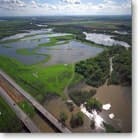California plans to cut water deliveries next year to their second-lowest level ever, the Associated Press (AP) reported, increasing the likelihood of less planting by farmers and rationing for cities from the San Francisco Bay area to San Diego.
After two years of dry weather and court-ordered restrictions on water pumping out of the Sacramento-San Joaquin Delta, reservoirs crucial to the state's water delivery system are at their lowest levels since 1977.
The state’s Department of Water Resources estimates that it will only deliver 15% of the amount local water agencies throughout California request every year. This year, water agencies received just 35% of the water they requested. The State Water Project delivers water to more than 25 million residents and 750,000 acres of farmland.
"For the amount of acres we've got, we're not going to have enough water to farm," said Mike Young, a fourth-generation farmer in Kern County. "We've got to start spending money on next year's crop now," Young said.
Young will be forced to fallow a fifth of his 5,000 acres, he said. Water will only go to his permanent crops, while the others will not be planted.
Fewer plantings would yield fewer crops and fewer farm hands hired, noted Jim Beck, general manager of the Kern County Water Agency.
"We're seeing a phenomenon in the Central Valley where growers who have been in the business of agriculture are laying off workers who have been with them for 20 or 30 years because they don't have the water," Beck said. "It's one thing to see brown lawns and shorter showers in urban areas. The real impact in the Central Valley is people are having to find new jobs."
The Metropolitan Water District, the agency that supplies water to about half the state's population, has depleted more than a third of its water reserves, the AP reported. Californians must immediately reduce their water use to stretch what little water is available, the agency's general manager, Jeff Kightlinger, said.
"We are preparing for the very real possibility of water shortages and rationing throughout the region in 2009," Kightlinger said.
Even with the dire projection, a wet and snowy winter could mean that cities and farms get more water, said Ted Thomas, a spokesman for the state water department. Still, that would not affect the court order.
"We are anticipating drastically reduced water supplies, regardless of weather conditions," Laura King Moon, assistant general manager of the State Water Contractors, said in a statement.
Gov. Arnold Schwarzenegger has proposed building more dams and designing a new way to funnel water through or around the delta, but the proposals have not gained traction in the Legislature.
This year, Schwarzenegger called on water agencies to voluntarily cut water use 20% by 2020, although not issuing a mandatory conservation order, a strategy yet to be used by the state, Department of Water Resources Director Lester Snow said.
"The governor has sounded the wake-up call, and the clock is ticking," Snow said in a statement.
Source: Associated Press


